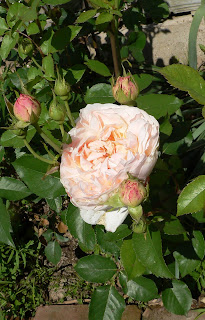Today, Feb. 29, 2012, our cabbage and broccoli seedlings out grew their nursery.
The following is the blog of their birth.
http://organicinstlouis.blogspot.com/2012/02/seeds-sprouted.html
It was moving time. We have different sizes of the Styrofoam planting trays. We move the plants up to the next size. It has been at least 8 years since we purchased our trays. I don't remember who made them. I do remember they were $5.00 each (that was wholesale). I was worried it would be a wasted expense. This wasn't the case. They have more than earned their keep.
The following site has some trays which are very similar to ours.
Ours have square holes instead of the round ones.
http://www.quickstartgardensupplies.com/index.cfm?fuseaction=category.display&category_id=23
The trays are supposed to keep the roots either cool or warm. In other words, keep the temperature from extreme fluctuations. The trays are designed to be placed on rails so the drainage holes are open to the air. The circulating air stops root growth through the holes, effectively root pruning the plants. It encourages the roots to develop and fill the planting hole.
The seedling to the left was planted in a soilless mix with no supplemental feeding. It is 10 days old. The temps in the room where it was at were at about 63 degrees.
The root development is perfect. I never have this nice of roots when I use other trays or containers.
This is a very strong plant and will be very successful when transplanted. Not susceptible to moving shock.
This picture shows the small cells the plant came from and the cells it will be transplanted to. You can see the second set of leaves.
The plants have been under 3 sets of shop lights. They are positioned with their leaves within a half inch of the light source. They are regular fluorescent bulbs except for one bulb which is the full spectrum bulb. We found when we used all full spectrum bulbs we didn't get the stocky growth we wanted. They tended to be spindly.
I transplanted all cabbages and broccoli. I will keep their same numbers throughout the growing cycle.
The following is the blog of their birth.
http://organicinstlouis.blogspot.com/2012/02/seeds-sprouted.html
It was moving time. We have different sizes of the Styrofoam planting trays. We move the plants up to the next size. It has been at least 8 years since we purchased our trays. I don't remember who made them. I do remember they were $5.00 each (that was wholesale). I was worried it would be a wasted expense. This wasn't the case. They have more than earned their keep.
The following site has some trays which are very similar to ours.
Ours have square holes instead of the round ones.
http://www.quickstartgardensupplies.com/index.cfm?fuseaction=category.display&category_id=23
The trays are supposed to keep the roots either cool or warm. In other words, keep the temperature from extreme fluctuations. The trays are designed to be placed on rails so the drainage holes are open to the air. The circulating air stops root growth through the holes, effectively root pruning the plants. It encourages the roots to develop and fill the planting hole.
The seedling to the left was planted in a soilless mix with no supplemental feeding. It is 10 days old. The temps in the room where it was at were at about 63 degrees.
The root development is perfect. I never have this nice of roots when I use other trays or containers.
This is a very strong plant and will be very successful when transplanted. Not susceptible to moving shock.
This picture shows the small cells the plant came from and the cells it will be transplanted to. You can see the second set of leaves.
The plants have been under 3 sets of shop lights. They are positioned with their leaves within a half inch of the light source. They are regular fluorescent bulbs except for one bulb which is the full spectrum bulb. We found when we used all full spectrum bulbs we didn't get the stocky growth we wanted. They tended to be spindly.
I transplanted all cabbages and broccoli. I will keep their same numbers throughout the growing cycle.
Feb. 29
1. Gurney's 2007 "HYBRID PACKMAN BROCCOLI" Destroyed any sprouts, due to poor germination/stunting
http://gurneys.com/
2. Shumway 2007 "GREEN GOLIATH BROCCOLI" Destroyed any sprouts, due to poor germination/stunting
2. Shumway 2007 "GREEN GOLIATH BROCCOLI" Destroyed any sprouts, due to poor germination/stunting
http://www.rhshumway.com/
3. Gurney's 2007 " HYBRID CORONADO CROWN" Destroyed any sprouts, due to poor germination/stunting
3. Gurney's 2007 " HYBRID CORONADO CROWN" Destroyed any sprouts, due to poor germination/stunting
http://gurneys.com/
4. Henry fields 2009 "PREMIUM CROP BROCCOLI" Destroyed any sprouts, due to poor germination/stunting
4. Henry fields 2009 "PREMIUM CROP BROCCOLI" Destroyed any sprouts, due to poor germination/stunting
http://www.henryfields.com/
6. Totally Tomatoes 2010 "RUBY PERFECTION CABBAGE" 24
http://www.totallytomato.com/
7 Baker Creek " EARLY JERSEY WAKEFIELD CABBAGE" 17
6. Totally Tomatoes 2010 "RUBY PERFECTION CABBAGE" 24
http://www.totallytomato.com/
7 Baker Creek " EARLY JERSEY WAKEFIELD CABBAGE" 17
8 Baker Creek " EARLY JERSEY WAKEFIELD CABBAGE" 20
Feb 29: All plants were installed in their new cells. I used the soilless mix by 1/2 weight and the other half was a mixture of equal parts: dried sifted manure, compost, rice hulls, and garden soil. after the plants were planted they were watered in with fish emulsion (1 TBS to 1 gallon well water). Left is the flat with the plants.
For more blogs by me visit at:
A blog mostly about quilting, but cooking, poetry, prose and a little gardening,
Not a garden blog. There are articles which have nothing to do with creating or gardening.
There are blogs on the new born baby kittens we found and are mothering. It is a blog where I will sometimes voice my opinions which will always be environmentally friendly.
As always, any pictures or writings are my own, if not credit will be given to the contributor. Please do not use without permission.















